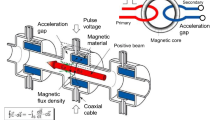Abstract
THE cold cathode arc, so called because of the very high current densities and low temperatures observed at the cathode, has been subjected to intensive theoretical and experimental study1–4. Many theories of the ‘cathode spot’ have been proposed, but distinguishing between them experimentally has proved to be a formidable task, because of the rapid and unstable motion of the spot, and the large pressure and temperature gradients existing within a very short distance of the cathode surface.
This is a preview of subscription content, access via your institution
Access options
Subscribe to this journal
Receive 51 print issues and online access
$199.00 per year
only $3.90 per issue
Buy this article
- Purchase on Springer Link
- Instant access to full article PDF
Prices may be subject to local taxes which are calculated during checkout
Similar content being viewed by others
References
Ecker, G., Erg. d. exakt. Naturwiss, 33, 1 (1961).
von Engel, A., Ionised Gases, second ed., 81 and 273 (Oxford University Press, London, 1965).
Hoyaux, M. F., Arc Physics (Springer, New York, 1968).
Guile, A. E., Proc. Inst. elect. Engrs., 118, 1131 (1971).
Robson, A. E., and von Engel, A., Proc. R. Soc., A 243, 217 (1957).
Langmuir, L., and Taylor, J. B., Phys. Rev., 44, 423 (1933).
Author information
Authors and Affiliations
Rights and permissions
About this article
Cite this article
ENDEAN, V. Stable cold cathode arc. Nature 254, 131–132 (1975). https://doi.org/10.1038/254131a0
Received:
Issue Date:
DOI: https://doi.org/10.1038/254131a0
Comments
By submitting a comment you agree to abide by our Terms and Community Guidelines. If you find something abusive or that does not comply with our terms or guidelines please flag it as inappropriate.



